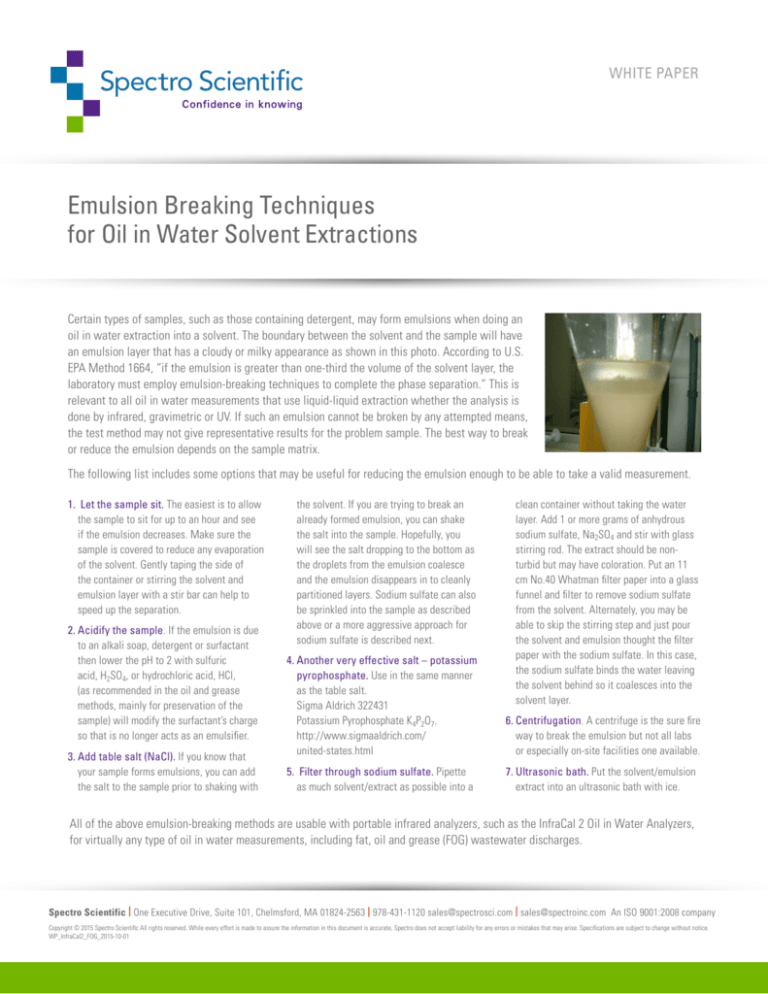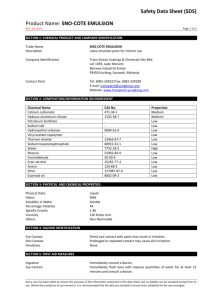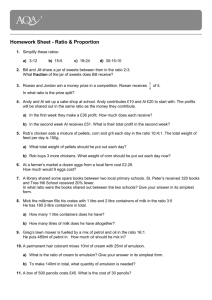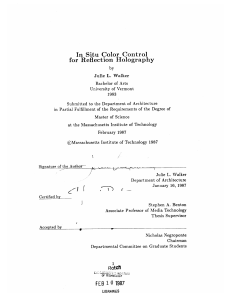
WHITE PAPER
Emulsion Breaking Techniques
for Oil in Water Solvent Extractions
Certain types of samples, such as those containing detergent, may form emulsions when doing an
oil in water extraction into a solvent. The boundary between the solvent and the sample will have
an emulsion layer that has a cloudy or milky appearance as shown in this photo. According to U.S.
EPA Method 1664, “if the emulsion is greater than one-third the volume of the solvent layer, the
laboratory must employ emulsion-breaking techniques to complete the phase separation.” This is
relevant to all oil in water measurements that use liquid-liquid extraction whether the analysis is
done by infrared, gravimetric or UV. If such an emulsion cannot be broken by any attempted means,
the test method may not give representative results for the problem sample. The best way to break
or reduce the emulsion depends on the sample matrix.
The following list includes some options that may be useful for reducing the emulsion enough to be able to take a valid measurement.
1. Let the sample sit. The easiest is to allow
the sample to sit for up to an hour and see
if the emulsion decreases. Make sure the
sample is covered to reduce any evaporation
of the solvent. Gently taping the side of
the container or stirring the solvent and
emulsion layer with a stir bar can help to
speed up the separation.
2.Acidify the sample. If the emulsion is due
to an alkali soap, detergent or surfactant
then lower the pH to 2 with sulfuric
acid, H2SO4, or hydrochloric acid, HCl,
(as recommended in the oil and grease
methods, mainly for preservation of the
sample) will modify the surfactant’s charge
so that is no longer acts as an emulsifier.
3.Add table salt (NaCl). If you know that
your sample forms emulsions, you can add
the salt to the sample prior to shaking with
the solvent. If you are trying to break an
already formed emulsion, you can shake
the salt into the sample. Hopefully, you
will see the salt dropping to the bottom as
the droplets from the emulsion coalesce
and the emulsion disappears in to cleanly
partitioned layers. Sodium sulfate can also
be sprinkled into the sample as described
above or a more aggressive approach for
sodium sulfate is described next.
clean container without taking the water
layer. Add 1 or more grams of anhydrous
sodium sulfate, Na2SO4 and stir with glass
stirring rod. The extract should be nonturbid but may have coloration. Put an 11
cm No.40 Whatman filter paper into a glass
funnel and filter to remove sodium sulfate
from the solvent. Alternately, you may be
able to skip the stirring step and just pour
the solvent and emulsion thought the filter
paper with the sodium sulfate. In this case,
the sodium sulfate binds the water leaving
the solvent behind so it coalesces into the
solvent layer.
4.Another very effective salt – potassium
pyrophosphate. Use in the same manner
as the table salt.
Sigma Aldrich 322431
Potassium Pyrophosphate K4P2O7.
http://www.sigmaaldrich.com/
united-states.html
6.Centrifugation. A centrifuge is the sure fire
way to break the emulsion but not all labs
or especially on-site facilities one available.
5. Filter through sodium sulfate. Pipette
as much solvent/extract as possible into a
7.Ultrasonic bath. Put the solvent/emulsion
extract into an ultrasonic bath with ice.
All of the above emulsion-breaking methods are usable with portable infrared analyzers, such as the InfraCal 2 Oil in Water Analyzers,
for virtually any type of oil in water measurements, including fat, oil and grease (FOG) wastewater discharges.
Spectro Scientific | One Executive Drive, Suite 101, Chelmsford, MA 01824-2563 | 978-431-1120 sales@spectrosci.com | sales@spectroinc.com An ISO 9001:2008 company
Copyright © 2015 Spectro Scientific All rights reserved. While every effort is made to assure the information in this document is accurate, Spectro does not accept liability for any errors or mistakes that may arise. Specifications are subject to change without notice.
WP_InfraCal2_FOG_2015-10-01









